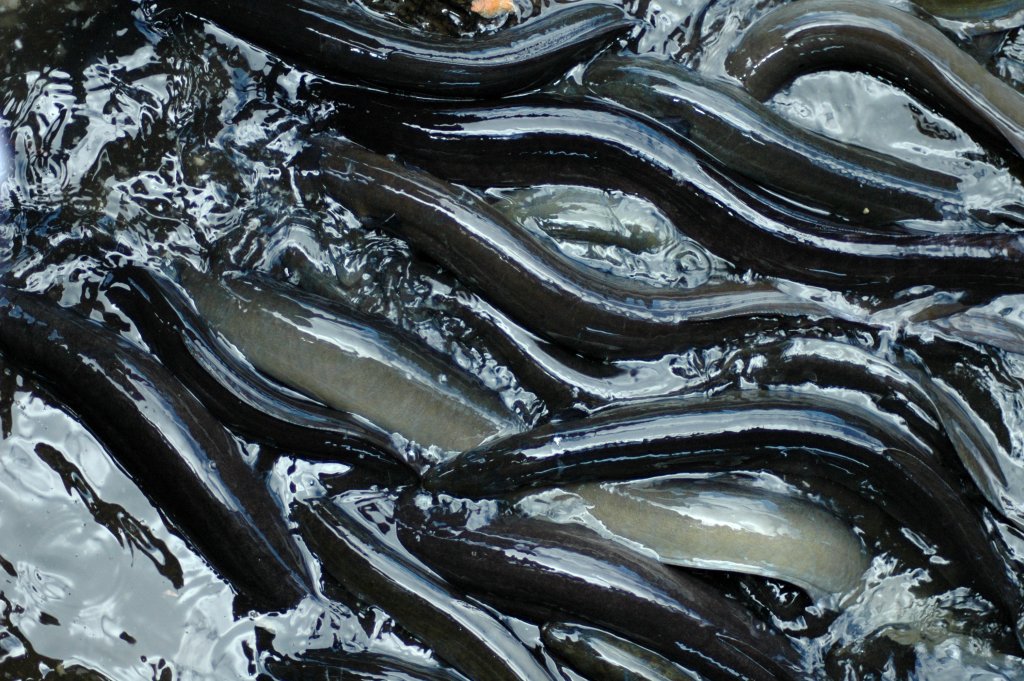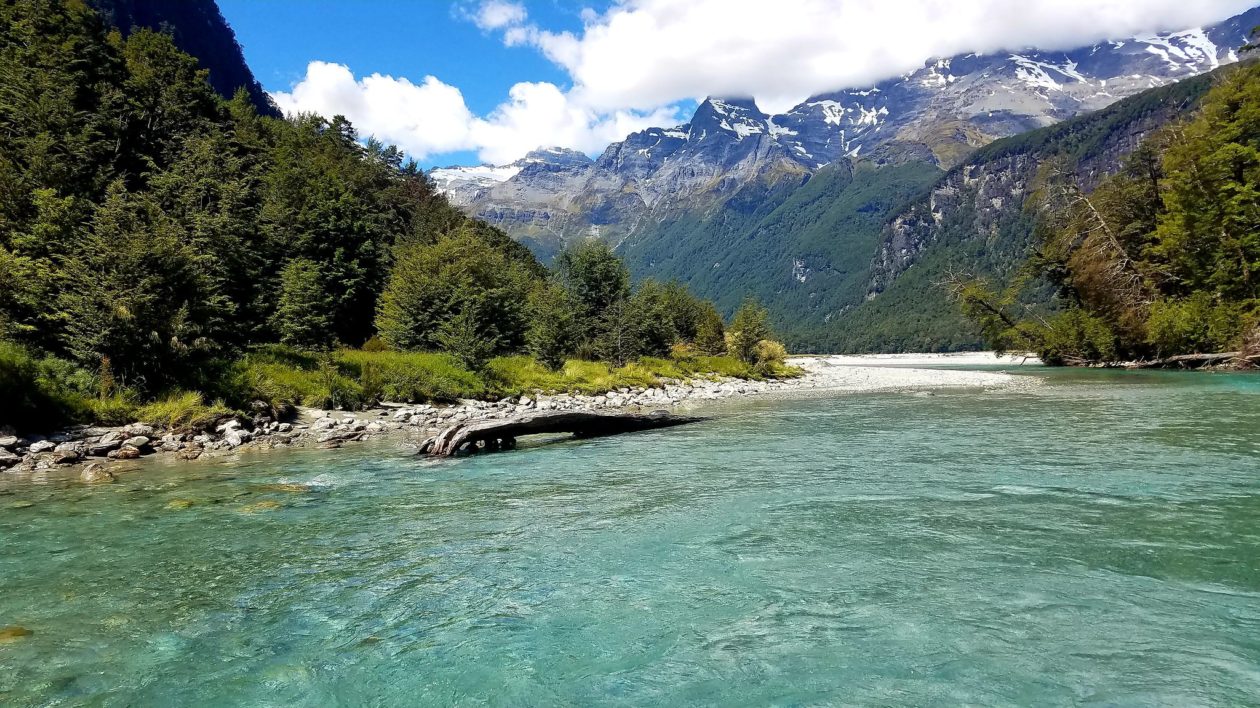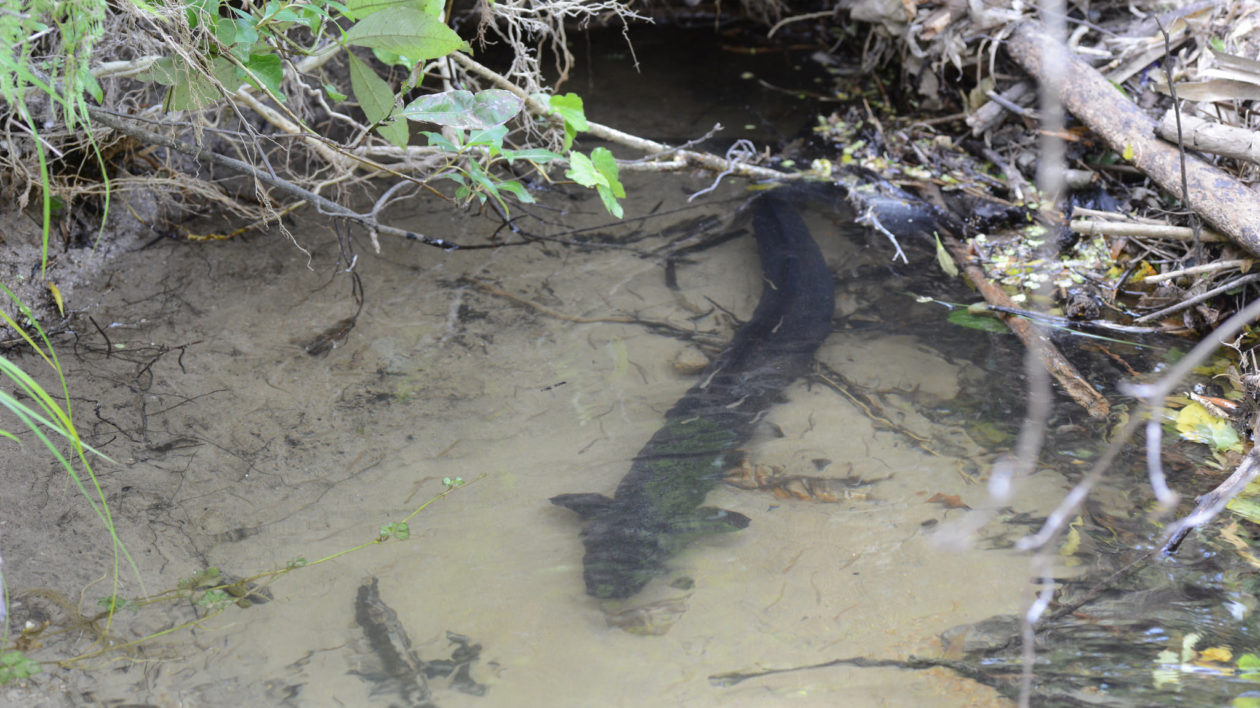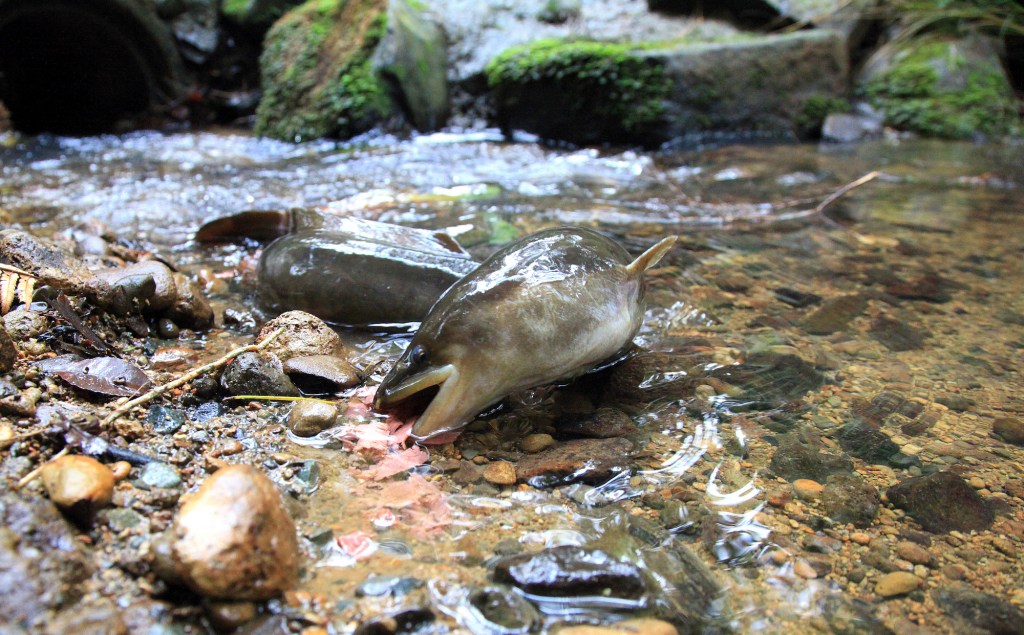I’ll never forget the first time I saw a freshwater eel.
It was after dark on a winter’s night in New Zealand, where I was searching for kiwi in the Zealandia wildlife sanctuary outside of Wellington. As we came upon a shallow, sandy-bottomed stream in the forest, our guide motioned for me to stop. He took out a piece of raw meat, bent down, and began waving it gently beneath the surface.
Seconds later a shape emerged from the watery gloom — sleek, dark, predatory. More than a meter long and thicker than my arm, it snatched the meat in a flash and then receded back downstream. What the heck was THAT?
The creature in question, I soon learned, was a New Zealand longfin eel, one of the strangest and most surprising fish I’ve ever encountered. They can climb ladders. Their larvae are see-through. They can live to be more than 100 years old. And they migrate thousands of miles to an unknown spawning ground in the tropics.
One Fish, Two Fish, Longfin, Shortfin
The New Zealand longfin eel (Anguilla dieffenbachii) is the only endemic freshwater eel species in the country. Colored dark brown and black, their dorsal fin is longer than their ventral fin, hence the name longfin. They are found throughout both the north and south island, including in high-elevation lakes and rivers.
Meanwhile, the shortfin eel (Anguilla australis) is found in New Zealand, Australia, and the Pacific Islands. Colored light brown and olive, shortfins are more often found in lowland areas like marshes and wetlands. (New Zealand’s third eel species, the spotted eel, is an occasional visitor from Australia.)
Eels of both species take up residence in a particular part of the lake or stream or marsh, and spend their time doing the usual eel things: hanging out under a bank or in some vegetation, and munching on everything from invertebrates to rodents to ducklings to fish.
So far, so normal. But when it’s time to breed, things get weird.
Spawning on the High Seas
Freshwater eels evolved from tropical marine ancestors near present-day Indonesia, so all 19 freshwater eel species return to the sea to breed.
“The holy grail of eel research is trying to find the spawnings areas,” says Don Jellyman, an emeritus fisheries scientist at New Zealand’s National Institute of Water and Atmospheric Research who studied eels for several decades. “We understand quite a lot about their freshwater ecology,” he says, “but what happens at sea is still very much a mystery.”
Anguilla from Europe and America migrate to spawning grounds in the Sargasso Sea — something scientists discovered in the 1920s by puttering around the ocean sifting seawater in search of smaller and smaller eel larvae.
“But we have never found any larvae of the longfin eels at sea,” says Jellyman. “It’s one of the few species for which we have no larval material.” Attempts at sieving in the Pacific have turned up a handful of shortfin larvae, but no longfins.
Between 2002 and 2010, Jellyman and his colleagues were the first to attempted to track eels as they migrated down to the sea and off to their mystery spawning grounds. But they ran into problems each time. Their tags used daylight to calculate latitude and longitude. “But our eels went very deep as soon as we released them, beyond where they could detect any light,” says Jellyman. (Incredibly, one eel was recorded swimming at a depth of 980 meters below the surface, or more than 3,200 feet.)
Without sufficient daylight, the tags only recorded locations for where the eels started their migration, and where the tag popped off at a pre-set time. The farthest signal they received was a tag that popped off about 700 meters east of New Caledonia, suggesting that the spawning grounds are located somewhere between there and the Tonga Trench. That was the first piece of conclusive evidence that the species migrates to the tropics to breed, a journey that takes about 5 to 6 months.

Floating Home on the Currents
We might not know exactly where the eels spawn, but we have a general sense of what happens next.
For the adult eels, it’s game over. All eel species are semelparous, meaning they breed only once at the very end of their lifecycle. “It’s a long time to wait for sex, they have it once, and then die after the event,” says Jellyman.
The eel larvae spend between 7 to 10 months at sea, feeding on very fine marine plankton as they drift back towards New Zealand on the currents. At this stage in their lifecycle they’re called leptocephalii, which means “leaf-shaped head” in Latin. “It’s pretty much a perfect description of the larvae,” says Jellyman. “It’s like a small, transparent leaf.”
They reach the New Zealand coast sometime between August and October. There they metamorphosize again into what’s called a glass eel, and gradually acclimate to freshwater before swimming upstream. “Historically there were huge shoals of glass eels,” says Jellyman. “There’s a report from the Waikato River where a shoal went past a stationary point for two days and two night without stopping.”
The little eels stay in the lower reaches of the rivers until summer, around January or February, before making another push upstream. Scientists discovered that the eels choose their route by following the scent of their own species upstream. Once in freshwater, the glass eels develop into juvenile eels, or elvers, and take on their dark coloration.
Many of New Zealand’s rivers are built up with hydropower dams, and Jellyman says that it’s common for young eels to find themselves trapped below these structures, much like salmon. But unlike other fish, the eels don’t need to jump in order to pass over the dam — because they can climb.
“Eels are quite happy to spend time out of water as long as they are damp and cool,” says Jellyman. “They can even climb vertical surfaces.” Many hydropower facilities place small ladders with a trickle of water running down them for the eels to use to climb over.
Shortfin eels tend to stay in the lower reaches of a river, also inhabiting swamps and wetlands. But the longfins keep migrating upstream, year after year, to the high elevation lakes and rivers. Once they find suitable habitat, they take up residence in one spot and stay there for years. And years. And years.

Returning to the Sea
Female longfins can live for up to 100 years, but a more typical lifespan is between 20 to 60 years. Though the oldest females can grow to about 5 feet long, they don’t grow quickly; most average between 1 and 5 centimeters of growth per year. Males are both shorter and shorter-lived, with a life expectancy of between 12 and 25 years.
In another strange twist, eel sex isn’t determined genetically, but by environmental conditions, much like sea turtles. Instead of temperature, the eels respond to the local environment and density of other eels. The more eels there are on a particular stretch of river, the greater the percentage of males in that population.
At a certain point, the environmental and physiological cues trigger the eels to begin their final migration back to the sea to breed. “Were not 100 percent sure what determines the switch,” says Jellyman. The timing isn’t strictly tied to age, but more to the eels’ health, body condition, and energy reserves. Only healthy eels will survive swimming thousands of kilometers to the tropics.
When they’re ready, the eels undergo yet another metamorphosis to become what are called silver eels. “Their eyes become larger, their coloration changes, and they become more sleek and tapered,” says Jellyman, all changes to help them adapt to the marine environment. “And then on a dark and stormy night they migrate downstream and out to sea, and that’s the last we see of them.”

Eels in Decline
Eels are an important part of Maori culture. “They were enormously important because they were widespread, relatively easily caught, highly nutritious, and you could transport them alive or smoke them,” says Jellyman. “As a consequence, they have built up rich folklore and understanding about eels and they feature a lot in Maori traditions and art.” (Somewhat confusingly, the Maori word for eel is tuna, like the pelagic fish of the same name.)
Unlike the Maori, European settlers in New Zealand had little respect for native eels. They introduced more familiar fish species, like brown and rainbow trout, and put a bounty on eels, who were known trout predators. “As I boy I used to get paid the equivalent of 2 cents per eel tail,” says Jellyman. “I’d make my pocket money going out and catching eels on a Friday night.”
Eventually, public sentiment changed as scientists discovered that eels play a key role as scavengers in the local ecosystem and actually benefit anglers. Jellyman explains that streams without eels have more trout, but the average size of each fish is much smaller because there are no predators to remove the surplus of juveniles. When there are eels around, fewer fish survive, but the survivors grow bigger.

Today eels are under threat from habitat loss, pollution, hydropower, and both recreational and commercial fishing. Although the shortfin eels are listed by the New Zealand government as not threatened, the longfin populations are in decline across the country.
Hydroelectric dams are still a major problem for both species on their return migration, particularly the longfins living farther upstream. “It’s easy enough to get small eels upstream, but it’s a heck of a process to get large eels back down,” says Jellyman. “If they enter a turbine it’s fatal.” And in low lying areas, pumping stations that help combat flooding turn eels to mincemeat.
Despite their declining status, both longfin and shortfin eels are still fished commercially. The fishery is managed with a quota system, which has been reduced in recent years as Maori and conservationists are reporting declines in the longfin populations.
Hopefully, both longfin and shortfin eels will benefit from upcoming conservation work by The Nature Conservancy’s New Zealand program, which is looking to introduce market-based approaches to help reduce freshwater pollution. They will also determine how tools like water funds and impact investments can benefit freshwater conservation, helping eels and other freshwater species.
In the meantime, Jellyman and his colleagues are planning another tagging attempt later this year, to once again try and locate the longfin’s spawning grounds. Until then, the mystery continues.




Justine…I just visited New Zealand and was lucky enough to see eel in two places, Sandy Bay in the Coromandel and Shakespear Park in Whangaparāoa. It was really cool! I wanted to learn about them and found this blog. Didn’t even notice it was TNC blog. Coincidentally, I’m on People Team and live in Colorado. Thanks for the great information! Love how small this world truly is.
Interesting read I myself have be relocating tuna heke above dams to below dams with a safe passage out to sea and also transferring mokotuna (elvers) above dams in my area just to ensure they survive and keep their life cycle going I do what I can . Tuna are very important
Please read anything you can on eels written and recorded by Professor Bill Kerrison, he had wisdom and knowledge beyond anyone in the world when it come to the endemic and exotic species, he man handled the migrating tuna in buckets past the four hydro dams on the Rangitaiki River, he is of Maori descent which is maybe why you don’t find much information on him, he teamed up with Auckland university scientist Mick ? who helped with environmental funding, please look him up because slot of questions in this report Bill already has answered years ago and it is so worrying to know that more funding is going to Mr jellyman and his project findings and not really helping the indangered endemic tuna species
They need to design a gps based tracker and keep trying. Maybe a detaching style and keep zeroing in on the spawning area.